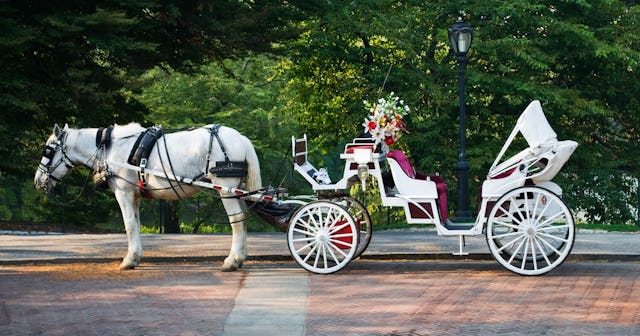Sudden Death Of A Central Park Carriage Horse Stirs Public Protest

Video of a Central Park horse repeatedly collapsing surfaced over the weekend, causing a public uproar
It’s a scene we’ve all seen play out on TV (and possibly even in person): a horse-drawn carriage pulling eager tourists around Central Park. For tourist destinations like New York City and Charleston, horse-drawn carriages are considered a classic — albeit controversial — attraction. But a heartbreaking new incident may mean this form of animal tourism’s days are numbered… at least in NYC.
Over the weekend, disturbing footage emerged of a carriage horse stumbling on its hind legs and slumping to the ground as its handlers tried to get the equine back on all four feet. Ultimately, the 12-year-old mare named Aisha had to be euthanized due to a cardiac emergency, per the Historic Horse-Drawn Carriages of Central Park. The trade group, which represents owners and drivers, released a statement via spokeswoman Christina Hansen.
“This medical emergency appears to be something that could happen to any horse, any time, anywhere, for any number of reasons, under a wide variety of conditions,” Hansen suggested, taking issue with reports that the horse was mishandled after collapsing. “Her regular vet was able to begin assessment and treatment within an hour. Unfortunately, she was never able to stand… Her owner, in consultation with the vet, made the difficult but humane decision to put her to sleep.”
Not surprisingly, that assurance did little to assuage animal rights activists and other concerned citizens who gathered on Sunday outside of the Clinton Park Stables in Midtown to protest. Led by longtime animal tourism critic NYCLASS, detractors held a “funeral march” right up Eighth Avenue to Central Park.
Said the organization’s executive director Edita Birnkrant, “This video is just the latest disturbing piece of evidence we’ve seen showing how poorly these horses are treated and what they go through. How can this be legal in New York City, supposed leader of the world? This is not tourism. This is abuse. It has to end.”
Even Mayor Bill de Blasio weighed in — although that isn’t a total surprise, given halting horse-drawn carriages was one of his earliest campaign promises. “The video of a horse collapsing and dying in Central Park yesterday is painful and says so much about a persistent problem,” he tweeted. “We’ve made real progress in animal welfare but we must go further. The NYPD’s Animal Cruelty Investigation Squad is on the case and WILL get answers.”
However, Historic Horse-Drawn Carriages of Central Park insists this was an isolated and freak issue. “Medical emergencies can happen to the healthiest horses, receiving the best, highly-regulated care,” the organization said. And it’s true that in cities like New York City, horse-drawn carriages truly are heavily regulated. This includes horses being forbidden from working in extreme temps (hello, summer in Manhattan!).
But this by far isn’t the first time animal rights groups and animal tourism groups have butted heads and surely won’t be the last. In 2011, a New York City carriage horse by the name of Charlie suffered a similar fate. At the time, animal welfare groups pushed for cities to embrace “horseless carriages” — aka vintage-replica electric cars.
In certain cities where horse-drawn carriages are legal, there exist few regulations to ensure the safety and wellbeing of the animals. And, according to PETA, there are no laws preventing “old, injured, or spent horses from being sent to slaughter.”
Horse-drawn carriages aren’t the only type of animal tourism this incident is causing people to scrutinize. Since people love animals and want to experience native wildlife, animal tourism is a big industry (think riding elephants in Thailand or swimming with pigs in the Bahamas). But per National Geographic, there’s a dark underbelly to many of the companies that offer animal tourism-based attractions.
If you’re considering any sort of travel entertainment involving animals, National Geographic recommends referring first to the “five freedoms”: internationally recognized tenets that serve as a baseline for ethical treatment.